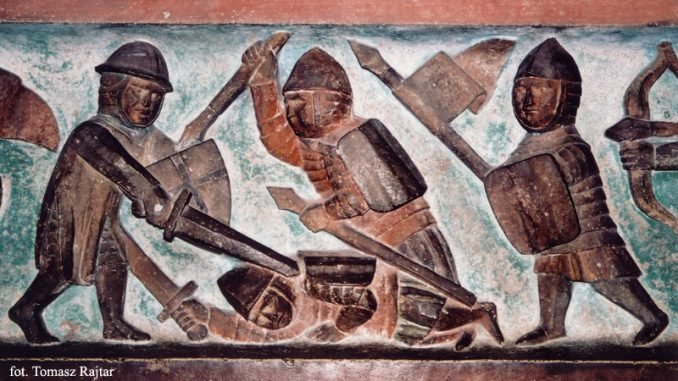
Archaeologist and military historian Manvydas Vitkūnas said that medieval pillaging campaigns which later developed into wars of expansion were what laid the foundations for state building.
“With their military tactics and weapons, our Baltic ancestors were neither better nor worse than surrounding peoples. Sometimes they’d be victims of attacks, payers of tribute, but there were periods when Lithuanians, Curonians and other Baltic tribes terrorized their neighbours with aggressive, far-reaching military campaigns,” said Vitkūnas, of Jonas Žemaitis Military Academy in an interview with Lietuvos Žinios.
– Europe first heard of Lithuania in 1009 when Saint Bruno of Querfurt was killed with a blow to the head by pagans near the border of Lithuania. What was he hit with? What weapons did the pagans use?
– The story that has reached us from the Quedlinburg Chronicle does not give us any more information about the Baltic art of war. It only says that alien peoples came to our lands, but their attempts to establish a contact with the locals on the border failed. Similarly, Saint Adalbert had been killed by a Prussian in 997. In both cases, it was not the Balts who went somewhere and killed the missionaries. The missionaries themselves came to the Baltic lands.
– Did pagan Balts use sophisticated weaponry?
– If we’re talking about the Lithuanian tribe specifically, which made up the core of the Lithuanian state in the 13th century, their weapons were almost identical to those used by other Baltic tribes, as well as Slavs and Ugro-Finns.
It is likely that at the start of the millennium elite warriors of some neighbouring regions (the Duchy of Polotsk, for example) were better armed than Lithuanians, because they had developed crafts and trade centres there, the dukes had accrued considerable resources and could better equip their troops. However, as Lithuanian expansionist forces grew stronger and Lithuanian dukes led bigger armies, their weapons got better.
Successful campaigns led by Lithuanians suggest that our forefathers had as much military skill and weaponry as their neighbours, in some cases even surpassed them. Otherwise, they would have been subjected to attacks from neighbouring tribes rather than set out on expansion themselves. Because of their numerous military campaigns, Lithuanians would sometimes be called “Vikings of the land”.
What we know from written sources as well as archaeological excavations, there were periods when our ancestors were attacked and defeated, while at other time Lithuanians, Curonians and other Baltic tribes would terrorize their neighbours during military campaigns.
Importantly, after the Lithuanian state emerged in the 13th century, it immediately had to face strong enemies but found ways to defend itself. Although I am personally fascinated by the “Vikings of the land” period of the 12th and 13th centuries, more impressive was Lithuania’s feat in the 13-15th centuries to hold out against the German Teutonic Order, which was undoubtedly a more powerful adversary and had behind it the support of virtually entire Catholic Europe. Despite political, military and organization advantages of the Germans, Lithuanians succeeded in defending themselves against the crusaders.
– If the early history of the Baltic tribes is one of brutal power, what were the aims of the wars? Were they purely about plunder?
– War plunder was one of key sources of wealth for Balts as much as for their neighbours, helping warlords to secure resources, from luxury items to metals and slaves.
Plunder campaigns were a way to survive bad crops as well as to enrich oneself. How often different tribes did it depended on their military capabilities and objective geopolitical circumstances: if their neighbours were wealthy, robbing them was a tempting possibility. If they were also vulnerable, the attackers could expect success at minimal cost.
As tribal elites grew stronger, military campaigns took on additional functions not just for plunder but to expand and impose authority. If warlords could impose and maintain their rule in neighbouring lands and force their residents to pay tribute, they did it. It was one of the main methods of state building.
War captives would usually be made slaves. There are documented cases of Lithuanians selling their slaves. From the times of the wars with the German Teutonic Order, there are isolated cases of sacrificing war captives to the Baltic gods.
– What were the principle pillaging areas for Lithuanian warriors?
– Their main target were Eastern Slavs (in the territories of modern-day Belarus and Russia). However, the victims of Lithuanian offensives were also Poles, Estonians as well as other Baltic tribes, especially Latgalians, who got to experience the full terror of Lithuanian attacks.
When the Livonian and the German Orders settled on the eastern coast of the Baltic Sea, the Christian newcomers had not only conquer the local tribes but also defend themselves against invasions from Lithuanian, Yotvingian and other Baltic tribes. The furthest that Lithuanian warriors ventured was Karelia (on the border of present-day Russia and Finland).
– Were there wars among the Baltic tribes? What were their consequences?
– Unfortunately, there was less Baltic unity than we’d like to see looking back from the 21st century. Unity was lacking not just among Baltic tribes but within too.
Recall the methods that [Lithuanian 13-century king] Mindaugas used to unite Lithuanians. Where persuasion failed, sword would work. All medieval states were forged like this: Lithuania, Poland, Hungary and many others. Someone amassed power, others lost their heads.
Unity can be achieved through internal effort or through external force. The latter was much more common than the former. Certainly, there are examples of Baltic tribes coming to one another’s aid, joining forces for a common struggle, but at other times they’d cut each other’s heads off.
For example, in at the end of the winter of 1205 a large army of Lithuanian Duke Žvelgaitis having just pillaged the lands of Semigalians and Livonians set out to plunder Estonia by way of the German-founded city of Riga. Fearing Žvelgaitis’ wrath, the Germans met his army with a generous feast. When the Lithuanians headed on for Estonia, the Semigalian Duke Viestartas, who had some personal issues to settle with Žvelgaitis and the Lithuanians, came to the Germans. While the Lithuanians were pillaging Estonians, the Semigalians forged a union with the Germans.
The Estonian campaign was a success – Lithuanians were heading back carrying a wealth of loot and captives. It was snowy, the Lithuanians were marching in a narrow and long line. Žvelgaitis himself was sleeping in a sleigh. While passing a hilly place, the Lithuanians were suddenly attacked by Semigalians and Germans. Žvelgaitis never got to rise from the sleigh – one knight of the Bishop of Riga stabbed him with a spear and Semigalians chopped off his head. The Lithuanians were left in the field headless – the Semigalians packed up their heads as a trophy.
– Is it fair to say that what drove Balts together was the need to defend themselves against aggressive neighbours? Military and strategic calculation played a bigger role than ethnic and cultural affinities?
– Ethnic and cultural affinities and worship of the same gods certainly helped different tribal leaders to find a common language. However, in the end the unification of the Balts never happened. Lithuanians, who ended up dominating the Lithuanian state were fully joined only by the Highlanders (Aukštaičiai – some historians and archaeologists believe that their lands were stretching across what is now central Lithuania) and the Samogitians, while the Curonians, Semigalians, Selonians, Yotvingians joined only in part.
Lithuania could not incorporate the Prussian, Nandruvian, Skalvian, Latgalian lands because they were conquered by the German orders. On the other hand, many of these tribes (perhaps with the exception of the Latgalians) moved to the territory controlled by the Lithuanian state, there are a number of cases from the 13th century.
Of all the Baltic tribes, only the Lithuanians established a state in the Middle Ages. However, their state quickly expanded to the east and soon lost its exclusively Baltic character. Military power and expansion opportunities were more important for the Medieval state of Lithuania than the ethnic homogeneity of its peoples.

Be the first to comment